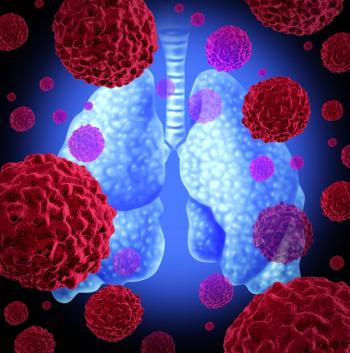
Oncology NEWS International
- Oncology NEWS International Vol 14 No 3
- Volume 14
- Issue 3
60 Gy Standard Radiotherapy for NSCLC Challenged
This special “annual highlights” supplement to Oncology News International is acompilation of major advances in the management of lung cancer during 2004, asreported in ONI. Guest editor Dr. Roy Herbst discusses these advances in clinicalmanagement, with a focus on developments in adjuvant therapy for early disease,targeted therapy, and new chemotherapy findings.
CHAPEL HILL, NC-"Localfailure in inoperable non-small-celllung cancer (NSCLC) is high, about80%-and cure is impossible withoutlocal control. The radiotherapycommunity has not addressed thisproblem," said Julian C. Rosenman,MD, PhD, professor of radiation oncologyat the University of NorthCarolina (UNC), Chapel Hill. "A 10-cm tumor compared with a 1-mmtumor has a 1-million-fold increasein size, but our response is to reducedose." For example, he said, a T1c prostate tumor is treated with 75 Gyof radiation, whereas a vastly largerstage IIIa or IIIb NSCLC is typicallytreated with 60 Gy.
Questioning 60 GyDr. Rosenman discussed evidencethat the 60-Gy dose is insufficient inthis patient population, and reportedon UNC data suggesting that doseescalation improves survival. The 60-Gy standard, he said, is based on adecades-old Radiation Therapy OncologyGroup study (RTOG 73-01)that was conducted before the availabilityof computed tomography scansand contemporary chemotherapy.This dose has been challenged in fourrandomized studies but not bested.For example, Johnson and colleaguesrandomized 319 patients withlocally advanced NSCLC to receivevindesine (Eldisine) 3 mg/m2, standardthoracic radiotherapy of 60 Gyover a period of 6 weeks, or bothvindesine and thoracic radiotherapy (Ann Intern Med 113(1): 33-38,1990). Median survival time was 8.6months for radiotherapy alone, 9.4months for radiotherapy plusvindesine, and 10.1 months forvindesine alone."The investigators concluded thatradiotherapy does not prolong survivalover drug therapy, but an alternativeinterpretation is that 60 Gy istoo low a dose for cure and too highfor palliation," Dr. Rosenman said."Most patients today are being treatedwith 55 to 60 Gy. Perhaps a millionpatients have been treated at theselevels. Shame on us."Dose Pushed to 74 GyDr. Rosenman and colleagues examinedthe radiotherapy dose in UNCstudy LCCC 9603 for inoperable stageIIIa/IIIb NSCLC patients with a performancestatus of 0 or 1. Patientswere treated with inductioncarboplatin (Paraplatin) to AUC 6 andpaclitaxel 225 mg/m2, with cyclesstarting on days 1 and 22. Beginningon day 43, patients received concurrentchemoradiotherapy weekly withcarboplatin to AUC 2 and paclitaxel45 mg/m2, and radiation doses wereescalated from 60 to 74 Gy. In 62 patientswith NSCLC on carboplatin/paclitaxel with radiation escalatedfrom 60 to 74 Gy, survival at 1 yearwas 71%, at 2 years was 50%, at 3years was 38%, and at 5 years was29%. Median survival time was 24months, at a median survivor-followupduration of 43 months. Dr.Rosenman said five other recent studiesusing 60 Gy reported median survivaltimes of 15.6 to 19 months. Headded that the radiation dose in theUNC study was escalated only to74 Gy because it hit the "DCP-orDoctor Chicken Point" rather thanbecause of adverse effects.Phase III TrialConcurrent chemotherapy with radiotherapyhas produced promisingresponses in NSCLC, perhaps owingto the radiosensitizing effects of chemotherapy."There are also hints thatbetter local control might improvesurvival," Dr. Rosenman said. Consequently, he and colleagues set aboutdesigning a multi-institutional, phaseIII trial to compare high-dose vs standard-dose radiotherapy with concurrentchemotherapy in patients withstage IIIa or IIIb NSCLC. Each treatmentregimen will be further randomizedto amifostine (Ethyol) or noamifostine (see Figure 1).The hope isthat amifostine will permit more tolerableradiotherapy dose-escalation,which might translate into longersurvival.
Articles in this issue
almost 21 years ago
Smoking Speeds Progression of Pancreas Caalmost 21 years ago
Alcohol, Obesity, and Smoking Risk Factors for HCCalmost 21 years ago
Adding Bevacizumab Improves Response to Oxaliplatin Regimensalmost 21 years ago
Capecitabine Promises Convenience, Efficacy in LARC, Five Studies Showalmost 21 years ago
Avastin Enhances FOLFOX Efficacyalmost 21 years ago
Panitumumab, Anti-EGFR MoAb,Promising in Colon Canceralmost 21 years ago
Oxaliplatin/Gemcitabine Effective in Advanced Pancreatic Canceralmost 21 years ago
Study Strengthens Evidence of Link Between Liver Cancer and Diabetesalmost 21 years ago
Capecitabine Promises Convenience, Efficacy in LARC, Five Studies ShowNewsletter
Stay up to date on recent advances in the multidisciplinary approach to cancer.































































































